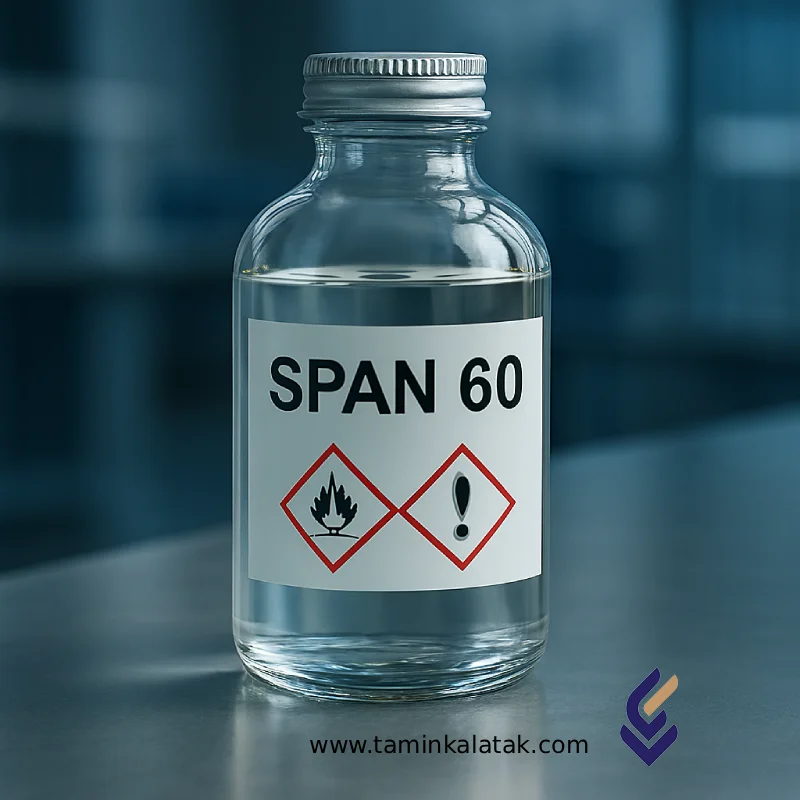Span 60
Span 60, also known as Sorbitan Monostearate, is a non-ionic emulsifier obtained by the esterification of sorbitol with stearic acid.
It is widely used in the food, cosmetic, pharmaceutical, and chemical industries due to its excellent compatibility with oils, thermal stability, and emulsifying ability in water-in-oil (W/O) systems.
Span 60 appears as a yellowish to light brown waxy solid or powder, soluble in oils and organic solvents, but practically insoluble in water.
Chemical Composition and Structure
-
Chemical Name: Sorbitan Monostearate
-
Molecular Formula: C₂₄H₄₆O₆
-
Molecular Weight: ≈ 430.6 g/mol
-
CAS Number: 1338-41-6
-
Chemical Type: Non-ionic fatty acid ester
-
HLB Value: ~4.7 (ideal for W/O emulsions)
Structure Description:
Span 60 consists of a hydrophilic sorbitol moiety esterified with stearic acid, resulting in a molecule that effectively stabilizes oil-based systems while providing controlled emulsification.
Physical and Chemical Properties
| Property | Typical Value |
|---|---|
| Appearance | Yellowish to light brown waxy solid or powder |
| Odor | Mild, nearly odorless |
| Density (20°C) | ≈ 1.03 g/cm³ |
| Melting Point | 53–57°C |
| Solubility | Insoluble in water; soluble in oils and organic solvents |
| Thermal Stability | Stable under normal food and cosmetic processing conditions |
| Ionic Nature | Non-ionic |
Applications
1. Food Industry
-
Used as an emulsifier and stabilizer in margarine, non-dairy creamers, chocolates, and cakes
-
Improves texture, consistency, and product stability
-
Prevents fat crystallization
-
Complies with FAO/WHO and FDA food additive standards (E491)
2. Cosmetics and Personal Care
-
Emulsifier in creams, lotions, balms, and ointments
-
Enhances stability of oil-based phases and improves texture
-
Provides smooth skin feel and improved viscosity control
3. Pharmaceutical Industry
-
Used in controlled-release drug formulations
-
Enhances stability of creams, suspensions, and ointments
-
Improves bioavailability of lipophilic active ingredients
4. Chemical and Industrial Applications
-
Functions as a stabilizer and dispersant in lubricants, industrial oils, waxes, and coatings
-
Improves blend uniformity and product stability
Advantages
-
High compatibility with vegetable and mineral oils
-
Excellent thermal and chemical stability
-
Non-toxic and safe within permitted concentrations
-
Enhances shelf life and emulsion quality
-
Can be easily combined with other emulsifiers (e.g., Tweens) to adjust HLB values
Limitations
-
Insoluble in water, requiring combination with high-HLB emulsifiers for O/W systems
-
Excessive use may alter texture or consistency of end products
-
Must adhere to international regulatory standards for food and pharmaceutical applications
Safety and Handling
-
Safety: Safe at recommended concentrations; prolonged or direct contact with skin or eyes should be avoided
-
PPE (Personal Protective Equipment): Use gloves, mask, and safety goggles when handling the product
Storage Conditions:
-
Store in tightly sealed containers, protected from moisture and direct sunlight
-
Recommended storage temperature: 15–30°C
-
Keep away from strong oxidizing agents and heat sources
Shelf Life: Minimum 24 months under recommended conditions
Summary
Span 60 (Sorbitan Monostearate) is a versatile, non-ionic emulsifier derived from natural fatty acids.
Its excellent compatibility with oils, thermal stability, and low HLB value make it ideal for water-in-oil (W/O) emulsions in a wide range of food, cosmetic, pharmaceutical, and industrial formulations.
It provides reliable emulsion stability, improves product texture, and ensures consistent quality in end applications.
Span 60
| Parameter | Typical value/range | Unit / Description |
|---|---|---|
| Chemical name | Sorbitan monostearate (Sorbitan monooctadecanoate) | (aka Span‑60) |
| Chemical formula | C₂₄H₄₆O₆. | — |
| Molecular mass | 430.62 | g·mol⁻¹. (MilliporeSigma) |
| CAS number | 1338‑41‑6. | — |
| EC/EINECS number | 215‑664‑9 (listed in distributor sources). | — |
| Physical appearance | Waxy solid — cream to pale yellow flakes or powder | — |
| Melting point | ≈ 51–57 °C (typically 52–55 °C in manufacturers' specifications). | °C |
| Density/volume ratio (Density, 20 °C) | ≈ 0.98 – 1.03 g·cm⁻³ (typically ~1.00 g·cm⁻³ in commercial data). | g·cm⁻³ |
| Vapor pressure (Vapor pressure, 20 °C) | Very low; < 1.4 hPa (reported at least at 20 °C). | hPa |
| Moisture | ≤ 1.0 – 1.5 % w/w (depending on grade; food grade typically ≤1.5%). | %w/w |
| Purity/Viscosity/index | ≥ 95% (manufacturer/grade is determinative; FCC/NF grade is typically >98% for food/pharmaceutical applications). | % |
| Flash point | Waxy solid — viscosity varies with temperature and grade; exact data should be obtained from COA. | — |
| Thermal stability | Nonflammable/non-flammable (waxy solid) — risk of ignition in dusty conditions. (SDS provides precautionary statements). | — |
| Main applications | Stable at typical process temperatures up to melting point; decomposes at very high temperatures. | — |
| Typical packaging | W/O emulsifier in food (chocolate, ice cream, margarine), cosmetic (cream, lotion), pharmaceutical (suspension/encapsulation), industrial (paints, coatings, lubricants). | — |







